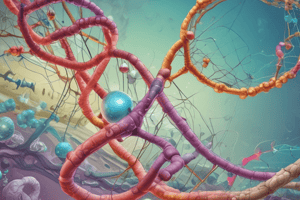Podcast
Questions and Answers
What is the sugar molecule found in RNA?
What is the sugar molecule found in RNA?
- Deoxyribose
- Fructose
- Ribose (correct)
- Glucose
What is the function of DNA in cells?
What is the function of DNA in cells?
- Gene regulation
- Genetic information storage (correct)
- Protein synthesis
- Catalysis
Which of the following is NOT a type of RNA?
Which of the following is NOT a type of RNA?
- tRNA
- mRNA
- rRNA
- DNA (correct)
What is the base pairing rule for Guanine in DNA?
What is the base pairing rule for Guanine in DNA?
What is the name of the rules that describe the equality of purine and pyrimidine bases in DNA?
What is the name of the rules that describe the equality of purine and pyrimidine bases in DNA?
What is the function of some RNA molecules (ribozymes)?
What is the function of some RNA molecules (ribozymes)?
Flashcards are hidden until you start studying
Study Notes
Structure and Function
- Nucleic acids are long-chain biomolecules composed of nucleotides
- Each nucleotide consists of:
- A five-carbon sugar (ribose or deoxyribose)
- A phosphate group
- A nitrogenous base (adenine, guanine, cytosine, thymine, or uracil)
Types of Nucleic Acids
- DNA (Deoxyribonucleic acid):
- Double-stranded helix
- Sugar molecule is deoxyribose
- Found in the nucleus of eukaryotic cells and in prokaryotic cells
- Contains the genetic instructions for an organism
- RNA (Ribonucleic acid):
- Usually single-stranded
- Sugar molecule is ribose
- Found in the nucleus, cytoplasm, and ribosomes of cells
- Involved in protein synthesis, catalysis, and gene regulation
Nucleotide Composition
- Base pairing:
- Adenine (A) pairs with Thymine (T) in DNA
- Adenine (A) pairs with Uracil (U) in RNA
- Guanine (G) pairs with Cytosine (C) in both DNA and RNA
- Chargaff's rules:
- The amount of adenine is equal to the amount of thymine (A=T)
- The amount of guanine is equal to the amount of cytosine (G=C)
Functions of Nucleic Acids
- Genetic information storage: DNA contains the genetic instructions for an organism
- Protein synthesis: RNA molecules (mRNA, tRNA, rRNA) play a crucial role in the process of protein synthesis
- Gene regulation: RNA molecules (miRNA, siRNA) regulate gene expression by controlling mRNA translation
- Catalysis: Some RNA molecules (ribozymes) have enzymatic properties and can catalyze chemical reactions
Structure and Function
- Nucleic acids are comprised of nucleotides, which are made up of a five-carbon sugar, a phosphate group, and a nitrogenous base.
- The five-carbon sugar can be either ribose or deoxyribose, depending on the type of nucleic acid.
- There are five nitrogenous bases found in nucleic acids: adenine, guanine, cytosine, thymine, and uracil.
Types of Nucleic Acids
DNA (Deoxyribonucleic acid)
- Double-stranded helix structure
- Deoxyribose is the sugar molecule
- Found in the nucleus of eukaryotic cells and in prokaryotic cells
- Stores genetic instructions for an organism
RNA (Ribonucleic acid)
- Usually single-stranded
- Ribose is the sugar molecule
- Found in the nucleus, cytoplasm, and ribosomes of cells
- Involved in protein synthesis, catalysis, and gene regulation
Nucleotide Composition
Base Pairing
- Adenine (A) pairs with Thymine (T) in DNA
- Adenine (A) pairs with Uracil (U) in RNA
- Guanine (G) pairs with Cytosine (C) in both DNA and RNA
Chargaff's Rules
- The amount of adenine is equal to the amount of thymine (A=T)
- The amount of guanine is equal to the amount of cytosine (G=C)
Functions of Nucleic Acids
Genetic Information Storage
- DNA contains genetic instructions for an organism
Protein Synthesis
- RNA molecules (mRNA, tRNA, rRNA) play a crucial role in protein synthesis
Gene Regulation
- RNA molecules (miRNA, siRNA) regulate gene expression by controlling mRNA translation
Catalysis
- Some RNA molecules (ribozymes) have enzymatic properties and can catalyze chemical reactions
Studying That Suits You
Use AI to generate personalized quizzes and flashcards to suit your learning preferences.




